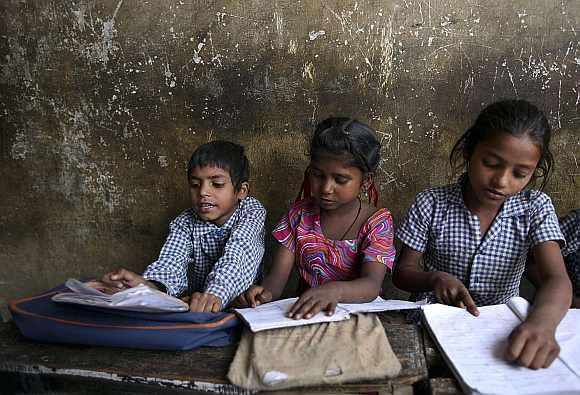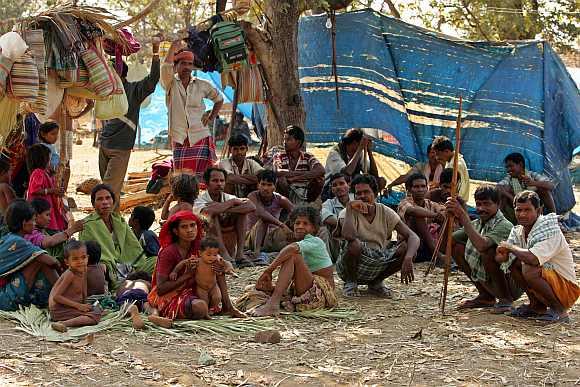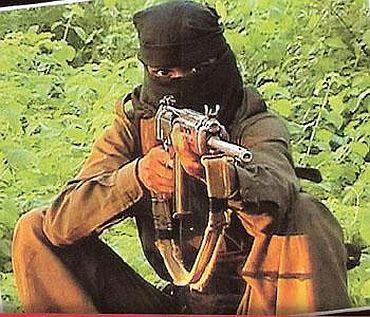 | « Back to article | Print this article |
The soft war against the Naxals in Chhattisgarh
The Chhattisgarh government has unleashed a "soft" tactic in its war against the Naxals - residential schools for poor children. Devjyot Ghoshal travels to Dantewada, Bastar and Sukma to see for himself
Phulder is short for his age -- seven or eight, he can't remember. So he can't reach the clotheslines, barely five feet off the ground. He jumps awkwardly a few times before the clothes are hung successfully. Grinning widely, he picks up a grimy soapbox, clambers over a large window and into a dormitory lined with wooden, double-bunk beds. This is where the 450 students of Kasoli Bridge Course Pota Cabin School stay.
It is a long, rectangular room, with rows of beds on both sides, and a narrow passage running through it. Unpainted aluminium trunks, mostly locked, are placed under the beds. There is little opulence here. Each bed has a pillow, cover and sheet, and the name of the occupant is written in chalk on the wood that faces the central passageway.
Phulder settles on a bed, feet swinging. "My village is an hour away. My parents live there," he mumbles slowly, "But I live here, and study English, Hindi, math and environmental sciences." Then, he begins to recite the English alphabet, stuttering slightly at O and P, and finally runs off to the adjacent dormitory.
Click NEXT to read further...
Education, they hope, will one day deliver them from poverty
Phulder could have been just another schoolboy, shy and struggling with his English. But he isn't — he is a part of the "war of hearts and minds" launched by the state against the Naxals, Leftist extremists who Prime Minister Manmohan Singh has called the country's worst internal security threat.
His schoolmates at Kasoli, 25 km from Dantewada, all come from villages caught in the middle of the protracted government-Naxal conflict that has caused more than 5,600 fatalities since 2005, according to the South Asia Terrorism Portal. Education, it is hoped, will one day find him a job somewhere and keep him away from the Naxal influence. That's perhaps why the school is in the middle of a barbwire-fenced camp constructed during the Salwa Judum movement -- a contentious state-initiated or state-supported tribal uprising, depending on which side one views it from, in the last decade -- that is protected by the Central Reserve Police Force.
Lakhen Sodi's parents are out hunting for wild boar as dusk falls on Irpa, a village of some 120 households in Sukma district. There is one functional hand-pump here, no healthcare facility within 20 kilometres, a three-room primary school with one somewhat-regular teacher and an erratic electricity connection that works for 15 days a month. The 25-km road to Irpa is untarred, with sharp gravel sticking out for miles. The last few kilometres have to be covered on foot. The Naxals come here at will, often several times a month.
The state, though, hasn't been overpowered in Irpa. Lakhen, 16, his younger brother, Santosh, his neighbour's son, Govind, and many other children, mostly boys, from this remote hamlet study in a clutch of government-funded residential schools in nearby towns. The boys are home for the summer vacation. Their education is fully -- subsidised by the Chhattisgarh government -- school fees, meals, uniforms, books, soap, oil and even a monthly allowance sometimes. The only money that the family needs to spend, nine-year-old Govind's father, Sukra Musakih, explains, is when the parents visit their wards, apart from the occasional gift.
Irpa is impoverished. Children with distended bellies, the classic manifestation of malnutrition, amble about, while the women of the village gather around a worn-out hand-pump, dodging chickens as they fill their pots of water. As darkness falls, there isn't a single bulb glowing here. But even Musakih can't deny that his son is getting an education. For free. This could, he hopes, one day deliver them from poverty. Although, as a Class XII-passout who could never find a job, he knows how difficult it will be.
Residential schools ensure children don't become part of Naxal cadre
Sitting in his large, elegant office in Krishi Bhawan, New Delhi, not far from Parliament House, Union Minister for Rural Development Jairam Ramesh sees in efforts like this the other offensive on the Naxal movement. "Some of these districts are engaging attention at high levels now. In a perverse way, the Naxals are responsible for bringing to (the government's) attention the development deficit in certain parts of the country." The task is truly mammoth -- so pitiable are the tribal villages of Chhattisgarh and so wretched their residents -- and precious time has been lost.
Chief Minister Raman Singh's office at Raipur, the capital of Chhattisgarh, too, is generously proportioned. There are bell-metal handicrafts, typical of his state, on the floor, and above the large, glass-topped desk where he sits is a photograph of former Prime Minister Atal Bihari Vajpayee.
Dressed in black and grasping a white hand-towel that has "CM" written on one corner, Singh rattles off the number of steps he has taken to win over the tribes of Dandakaranya -- a massive forest tract that roughly the mirrors the 39,100 square kilometres of undivided Bastar district -- and isolate the Naxals.
Large districts have been broken into smaller ones, which will bring the administration closer to the people and, hopefully, create jobs. Some of the brightest, young administrators have been posted in frontline areas. (Alex Menon Paul, the collector of Sukma who was kidnapped by the Naxals on April 21 and released two weeks later, was one of them.)
Bureaucrats at the district headquarters will be empowered to upgrade critical infrastructure like roads. His government will focus on value addition to forest produce through self-help groups. Height restrictions for recruitment to the police have been eased to let in more tribesmen. School uniforms are being sourced from tribes in order to supplement their incomes.
Yet, on the ground, the only initiative that seems to have taken off is education. Omprakash Choudhary, the fresh-faced 29-year-old collector of Dantewada, explains that this is an evolved version of a residential school model initially adopted by the state government's tribal department. "By making residential schools widely available in these districts, we are not only providing education to a large number of children who would have otherwise found it difficult to get to a school, but also taking care of other things," he says, with a reminder about the Naxal's penchant for breaking down school buildings as they also sometimes house paramilitaries.
With large residential schools, the Naxals must be especially careful. "The students get proper meals, so the issue of nutrition is tackled, and staying at these schools also brings down the costs for their families," the young IAS officer adds. "It also ensures that these children do not become part of the Naxal cadre base."
In Dantewada and Sukma districts alone, the government is constructing 53 residential schools, using a combination of state and central funding, with a total capacity of 25,000 beds, Choudhary informs. The two districts together have a population of about 500,000. And where it can't build, or afford to build, concrete buildings, it is putting up reinforced bamboo structures -- the pota cabins.
Pila Ram, 14, is Phulder's senior at Kasoli. The Dadas, as Naxals are known in these parts, would often visit his village, some 16 km away from his school, he reluctantly reveals. He doesn't, however, forget to add that his parents don't have access to electricity, a half-decent road or proper drinking water. But at Kasoli, Pila watches the news and the glitzy Indian Premier League cricket championship on a massive flat-screen television -- his favourite team, he adds with a smile, is the Kolkata Knight Riders, the former team of a very different Dada.
His only complaint: "There are not enough teachers." Some eight teachers manage this school of 450 boys, supported by a handful of assistants. The government is aware of this problem, and bureaucrats claim more teachers are being hired. "Our initial strategy was wrong. We were diluting the strength of teachers by trying to establish more schools. Now, we are focusing on creating centres where we can concentrate our resources," says P Anbalagan, the soft-spoken collector of Bastar.
Vacancy for 1000 govt docs in Bastar but only 10 employed
Young officers like Choudhury and Anbalagan are at the forefront of the "soft war" against the Naxals. They know that systemic changes need to be made in this effort. Road projects here, for instance, are awarded in faraway Raipur and New Delhi. Some contractors would deliberately set their vehicles afire, blame it on the Naxals and walk out of the project. So the local administration lobbied hard for a say in awarding and monitoring road projects -- something Chief Minister Singh seems to have agreed to.
The food fed into the public distribution system often ends up with the Naxals because they grab it from the hapless villagers. "The Naxals eat the same rice as the villagers, and we (the government) supply it," says another collector. In the Bastar district, there are vacancies for 1,000 government doctors; yet there are as few as 10 doctors around. The government has offered salaries of up to Rs 100,000 a month, and still there are no takers. The "108" ambulance service run by the Chhattisgarh government and the GVK group stops where the road ends -- it reaches many but leaves thousands of tribal villages out of its reach.
Dantewada's Livelihood College, a residential facility that teaches vocations skills to young men and women in one of India's most dangerous districts free of cost, is Choudhury's partial solution to yet another persistent problem of this impoverished region: unemployment. The college can support some 250 students at any given time, with courses that last between one and three months, and are conducted by IL&FS and IndiaCan.
Kattam Ramesh walks into a large, vinyl-floored room that houses a queen-size bed, a dining table an,d pushed against a wall, a shelf with an assortment of cleaning equipment. This is the housekeeping laboratory of the college. With reticence clearly etched on this face, 17-year-old Kattam haltingly explains that he is here to study the IL&FS course in hospitality from a far-flung forest village in the Sukma district that, as usual, lacks even the most basic of amenities.
He can barely even pronounce "hospitality" but says that he came here after hearing of the college from friends. "I have learnt some English here," Kattam reveals, trying to slip in a word or two of the language into the conversation, "But more than that, I have gained confidence. I couldn't even talk to unknown people properly earlier."
About 150 young people, many like Kattam, have been placed in jobs since classes started last December. Salaries, however, remain low at a few thousand rupees and not many want to venture too far away from home. But there is little regular work to be found at home, and the demand for employment will grow as the education system is ramped up.
For dealing with this, Choudhury, despite his foresight, has few answers. He hopes that some will be able to leave these disturbed districts by the end of school, which is why he has brought in specialised teachers all the way from Rajasthan's Kota, the coaching capital of India, to help local students land a place at engineering and medical schools. Two standalone residential schools, with students only studying science subjects, have been established in the district. These are called 'Choo Loh Aasma', or Touch the Sky. For the rest, there isn't much on offer.
The vast, wooded tracts of Dandakaranya, literally the forest of punishment, are laden with myths, some ancient and others contemporary. If age-old legends speak of Lord Rama coming to these forests to live in exile, recent folklore describe how the rulers of modern India abdicated responsibility for this territory and its many tribes. But the tales being woven today probably carry more hope than those in the past.
TOP photo features of the week
Click on MORE to see another set of PHOTO features...





